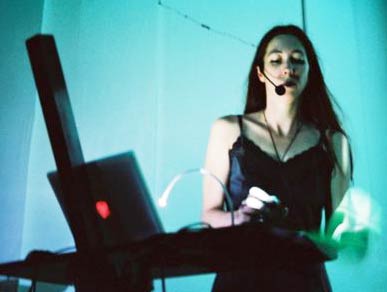| Theatre | New Zealand / Aotearoa | ||||||||||||||||||||||||||||||||||||||||||||||
BAFA © 2010. All material here is copyrighted. See conditions above. |
Helen Varley Jamieson
|

Photo: Helen Varley Jamieson performing in "swim - an exercise in remote intimacy" at the Mesto Zensk - City of Women Festival, Galerija Kapelica, Ljubljana, Slovenia, October 2003. Photograph by Nada Zgank. | Helen is a theatre and digital media artist, and an internet
professional. A diverse career has led to her current experimental
work in the use of the internet as a venue for performance,
specifically in bringing remote performers together in live
theatrical events. She calls this new art form cyberformance.
|
Naturally, I began to explore the blending of the two and began to experiment with the internet as a venue for
performance. Since 2002, most of this work has been done with the cyberformance troupe Avatar Body Collision, which consists of myself, Vicki
Smith (NZ), Karla Ptacek (UK) and Leena Saarinen (Finland).
Since our members live in New Zealand, Finland, the U.K. and cyberspace, all our devising, rehearsing and performing takes place in the internet environment. We've never actually all been together in a room. We haven't all met physically. Generally in the process, there will be one person in the group who is the driver of a particular work - this tends to happen organically. Usually this is the person who has stigated a particular theme or idea or who feels strongly about it, or perhaps simply the person who has the most time to devote to the work at that moment. But the actual content is created collectively, during improvisations, chat, email discussions and other research. Using chat software - primarily The Palace, iVisit and UpStage - we meet regularly online to develop the work. Scheduling rehearsals is a big issue as we are in 3 or sometimes 4 different time zones. For 'swim' in particular, a lot of the material was drawn from personal experiences of internet romance, with text extracted from emails and chat. The metaphor of swimming to reach someone across great distance naturally lead us to mythology, and tales of old about lovers who swim (conquer obstacles) to be together. By including the Greek myth of Hero and Leander, and the Maori legend of Hinemoana and Tutanekai, we embed ancient story-telling techniques into the digital age, conjuring up universal themes and speaking with a global voice. Rendering myth into cartoonesque digital art allows the audience to re-approach the material from a contemporary perspective, and rediscover its relevance to the times we live in today. Most of the texts in this work are my own, and those by others are from relationships or conversations with us or the work itself. There set choreographic elements in the work, such as a scene where two women reach out from their web cam windows to touch each other across cyberspace, while below them two other windows show fingers moving rapidly across keyboards. The 'crisis' of the performance occurs after the telling of the tragic story of Hero and Leander in The Palace, with the deaths of the lovers. In the webcams and on stage, our cyber-lovers begin to swim towards each other. As we swim, I (on stage) begin to drown and eventually collapse on the floor. The other 3 look out from their web cam windows and are horrified to see that I've drowned. They discuss among themselves what they might do, and decide that a story with a happy ending might revive me, so in The Palace they begin to tell the story of Hinemoana and Tutanekai. This gradually begins to revive me and leads me to the understanding that the cyberlovers are indeed real people at the end of the line. There is a photo & text synopsis on the web site, www.avatarbodycollision.org/swim/swim2.html. Links: helen varley jamieson: helen AT creative-catalyst.com www.creative-catalyst.com www.avatarbodycollision.org www.writerfind.com/hjamieson.htm |
|
|
Arts Dialogue, Dintel 20, NL 7333 MC, Apeldoorn, The Netherlands email: bafa@bahai-library.com |